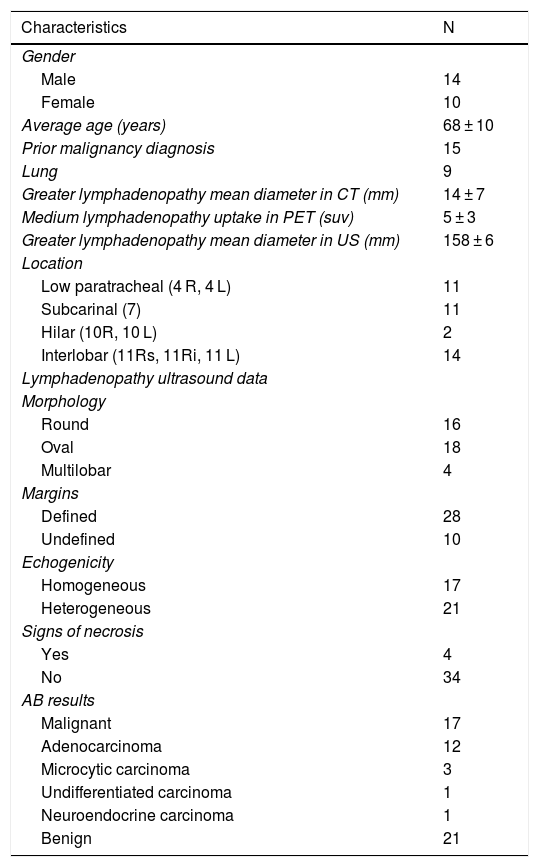The main objective was to analyze the technical variability of EBUS-elastography in the differentiation of benign and malignant hilar and mediastinal lymph nodes. As a secondary objective, the results of the EBUS-elastography in said differentiation were analyzed, comparing them with the anatomopathological results.
MethodsProspective and analytical study of lymph nodes in which EBUS-elastography was performed. Elastographic variables and their variability were analyzed.
Results24 patients and 38 lymph nodes were evaluated. Of these, 60.5 % had a history of neoplasia, 71 % of them were EBUS-elastography with diagnostic intention, 53 % were mediastinal staging of lung cancer. Both procedures were performed in 25 % of the patients. Lymph nodes were classified into elastographic colour patterns, red being characteristic of elastic tissues and blue of rigid tissues. The lymphadenopathies with apredominantly blue pattern were associated with an anatomopathological result of malignancy (86 % vs 14 %, OR 20.4 (3.1–245.1) p-value = .00015). Malignant lymph nodes presented less colour dispersion in the frequency histograms and a higher ratio of blue pixels and higher strain ratio. These variables showed a variability of 8.7 %, 9.9 % and 31.6 % respectively in repetitions in the same adenopathy. Finally, a 66 % of consistency was obtained in the event of colour pattern variability (p 0.0000).
ConclusionEBUS-elastography is feasible during EBUS and may be helpful in predicting malignant lymph node infiltration. The quantitative elastographic data show low variability in repetitions in the same adenopathy. The strain ratio is the most variable elastographic parameter.
El objetivo principal es analizar la variabilidad técnica de la EBUS-elastografía para diferenciar entre adenopatías hiliares y mediastínicas benignas y malignas. Como objetivo secundario, se analizan los resultados de la EBUS-elastografía en dicha diferenciación, comparándolos con los resultados anatomopatológicos.
Material y métodos: Estudio analítico prospectivo de adenopatías consecutivas en las que se realizó EBUS-elastografía. Se analizan las variables elastográficas y la variabilidad técnica de la EBUS-elastografía.
ResultadosMuestra de 24 pacientes, 38 adenopatías. El 60.5% presentaban antecedentes de neoplasia. El 71% tenían intención diagnóstica, el 53% para estadiaje mediastínico de una neoplasia conocida; el 25% de los casos con doble intensión. Se clasificaron las adenopatías en patrones de color elastográficos, siendo el rojo propio de tejidos elásticos y el azul de rígidos. Las adenopatías con patrón de color predominantemente azul se asociaron con resultado anatomopatológico de malignidad (86% vs 14%, OR 20,4 (3,1 -245,1) p = 0,00015). Se evidenció menor dispersión del color en los histogramas de frecuencias y mayor ratio de píxeles azules y strain ratio en adenopatías con resultado AP de malignidad frente a benignas. Dichas variables presentaron respectivamente 8.7%, 9.9% y 31.6% de variabilidad en las repeticiones dentro de la misma adenopatía. Se obtuvo un 66% de consistencia en el caso de los patrones de colores (p = 0,000).
ConclusionesEBUS-elastografía es una herramienta diagnóstica de estudio tisular factible durante la realización de EBUS, capaz de predecir la presencia de infiltración maligna ganglionar. Los datos cuantitativos elastográficos muestran escasa variabilidad en repeticiones dentro de la misma adenopatía, siendo el strain ratio el parámetro elastográfico más variable.












